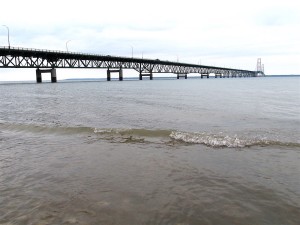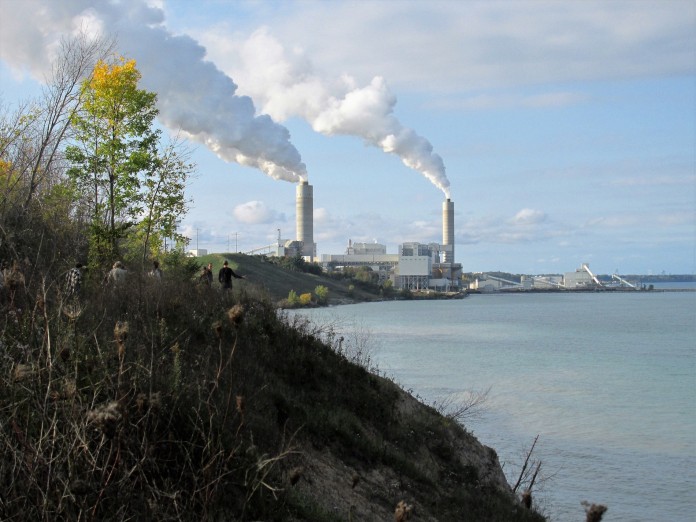MACKINAW CITY, Mich. — In early October, just as the leaves were beginning to turn color and people were starting to reach for their thermostat, I traveled through Michigan and Wisconsin with a group of 15 journalists from across the nation, and one from Hungary, to learn about the energy boom that’s happening across the Great Lakes region.
This boom is one that includes new sources of oil and gas, like those being drilled in Ohio and its eastern neighbor, Pennsylvania. But it also includes oil coming from Canada and the Dakotas, as well as coal, wind, solar, and energy created from farms, through the use of anaerobic digestion.
With all of these energy sources comes the infrastructure — the pipelines that are being installed or updated, the coal plants that are converting to natural gas, and the wind turbines that are being built for future wind farms.
All of these issues were part of our week-long trip — funded by the Institute for Journalism and Natural Resources, a nonprofit that strives to connect journalists with natural resource issues.
Choosing winners
There are many opinions about what our energy future should look like, which sources to champion and which ones will win the race.

At Mackinaw City, we learned about the massive, 4.5-mile stretch of underwater pipeline that runs beneath the Great Lakes, across the Straits of Mackinac, transporting light crude and natural gas liquids.
This pipeline, known as Enbridge Line 5, begins in Superior, Wisconsin, supplying fuels to the upper and lower peninsula of Michigan, extending into Ontario, Canada, and also into Toledo, Ohio via a separate line.
Fueling Michigan
Line 5 is responsible for providing 55 percent of Michigan’s propane needs, and enough light crude to produce fuel for 1 million passenger cars and trucks a day, in addition to diesel and jet fuel for commercial transportation.
But the aging line, which was installed in 1953, is a major concern for area residents who fear that a leak would devastate the region’s fresh water supply, and irrevocably affect the ecosystem.
And their concerns are not without reason. Enbridge, the company that owns the line, suffered a major incident in 2010, when one of its lines ruptured in southern Michigan, spilling oil into a tributary of the Kalamazoo River, and resulting in one of the largest inland oil spills in U.S. history.
“It really shook this company to the foundation,” said Jason Manshum, manager of public relations.

Over the past few years, Enbridge has increased its inspections, and now inspects the inside and outside of its lines on a regular basis, with more oversight from state government officials. Independent inspections have also been conducted, and the company has added additional anchors to support the line.
Manshum said the line is now the most-inspected pipeline in the world, and it’s pressure-tested at 1700 psi — more than five times the psi that it sees during use.
“You can, and you do have a healthy balance between providing the energy that we need and use on a daily basis, and protecting the natural environment that we all use and love,” he said.
- ••
Different perspective
But on the other side of the Mackinac bridge, on the shores of the Upper Peninsula, we met a group of environmental leaders and state environmental staff who say residents are still worried.
”There are some locations that aren’t necessarily appropriate for pipelines, and The Great Lakes is considered to be one of those,” said Jennifer McKay, policy director for Tip of the Mitt Watershed Council. “Cleanup here would be virtually impossible.”
Different era
Josh Mogerman, media director with the Natural Resources Defense Council, said a lot has changed since Line 5 was installed 60 years ago, including how we look at our natural resources, and the idea of climate change.
He said new infrastructure projects need to be considered carefully, especially when it comes to petroleum pipelines, which could “tie us into using a specific fuel source” for decades, particularly a source that is “very carbon-heavy.”
It wasn’t hard to see the range of opinions. Everyone said that they were concerned about the condition of Line 5, but some admitted that what they’d really like to do is shut it down.
What happens next? I couldn’t help but ask, what happens if they do shut it down? What would happen to more than half of the people of Michigan who rely on the line to heat their homes? Or the motorists who depend on the transportation fuels?
It was an honest question, and they gave me an honest answer, one that included several alternatives.
One alternative is to move the crude on top of the water, by vessel. This is currently illegal and poses a greater risk of spill.
Secondly, the company could move its oil by truck or by rail, but, as McKay pointed out, that is also risky.
Emergency response
In fact, we met with some Milwaukee-area firemen who said they already fear having oil railcars pass near houses and businesses, because the material is highly explosive.
The company could also replace its 60-year-old pipeline with a new, state-of-the art line, but McKay said even a new line still poses a risk.
The ideal option, she said, is to continue moving toward renewable and alternative energy.
But realistically, she said that can’t happen overnight.
- ••
Coal power
When we think about replacing one energy form with another, nothing stands out like the move from coal to natural gas.
In coal-producing states, we hear about the “war on coal” from people who claim environmental regulations are driving coal out of business. But it was encouraging to visit at least one former coal-fired power plant that made the switch to natural gas because it’s more efficient and saves money for the company and also its customers.

That plant was the We Energies Valley Power Plant, which provides electric and steam to 400 businesses in downtown Milwaukee. The company replaced two coal-fired units at its Valley Power Plant in 2014 and 2015.
“It was really a no-brainer for us,” said Tom Metcalfe, executive vice president. “Just because the cost of gas has come down so far, versus the cost of coal that used to be delivered to this (plant).”
Emissions of sulfur dioxide and mercury dropped 99 percent, he said. Nitrogen oxide and promethium are down 80 percent, and carbon dioxide is down 60 percent.
The company has made other conversions, as well, and Metcalfe predicted more plants will convert in the future.
Being diverse
But he said coal is still a big part of his company’s energy strategy, and he expects it will remain so for many years to come.
Part of the reason is the need for utility companies to diversify.
Metcalfe, like several other people I met on the trip, said it’s imperative that energy companies give themselves and their customers options.
Too much reliance on one energy source can put everyone at risk when markets change, or during extreme weather like the polar vortex of 2014 when extreme cold swept across central and eastern U.S.
“You have to have a mix of fuels,” Metcalfe said. “Think about what it would have meant in the polar vortex if we had only had natural gas. It would have been horrendously expensive for our customers. Coal was there to help us through that very, very difficult period.”
But depending on where you go, and who you ask, coal is still the biggest polluter.
Pollution concerns
Charles Michna and his family, who live in a rural area along the western shores of Lake Michigan, blame a nearby coal plant for a history of family health problems, and also health issues affecting their pets that drink from the surface water.
Charles, 63, held up a white lawn chair for reporters, covered in a residue that he says is from the coal plant. A window sill on his home bears similar material that he’s sure came from the power plant.
His family has pictures of waste material that has washed up onto the shores and they’re convinced it came from the power plant.
We also heard from community and environmental leaders who were concerned about the risk for asthma and respiratory defects near coal plants.

Common ground
It’s hard to argue with people who believe power plants are affecting their family’s health. It’s also hard to argue with power companies that have more money, more science, and are acting within the law.
Because we heard from so many people — sometimes on opposing sides of an issue — I kept trying to find the common ground.
One of the faith leaders who spoke to us said it best: “Everyone deserves to live in a safe environment where they can thrive.”

That’s really what people want: reliable energy, but in a way that is the least intrusive to their lives.
There’s not an easy answer, and I’m leery of anyone who says there is.
Balancing act
As one of our group leaders pointed out, industry gets a lot of blame, but we have to keep in mind, “society demands” those same things that industry provides. Including the 16 of us journalists, who spent the week riding a fuel-hungry tour bus, and crossed the breadth of Lake Michigan on a coal-fired ship.
The challenge is to find something that works for everyone — humans, environment and industry. I look forward to that challenge, and writing about how we can overcome it.











Thank you for the article Chris.
I live in Mundelein IL and was surfing information about Lake Michigan wind farms when I came across your article. Very cool you and your fellow journalists were able to take part in this information trek about such an important topic. Clean energy is important to me and the reason I keep my eye out for job opportunities in the field.
I hope you continue writing about the Great Lakes energy companies especially as we see more diverse alternative projects and their infrastructure. Safe and thriving. Good catch phrase for energy in general.